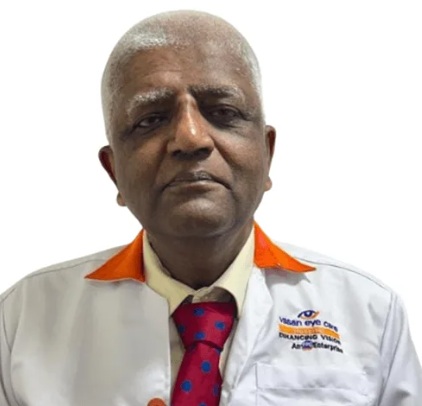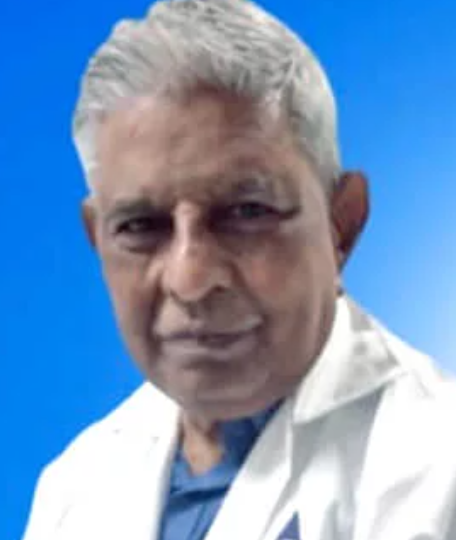Amblyopia Surgery: Align and Strengthen Vision
Dr. Jaideep Dhama

Treatment Duration
15 Minutes
------ To ------30 Minutes
Treatment Cost
₹ 23,000
------ To ------₹ 70,000

Table of Contents
- What is Amblyopia Surgery?
- What may happen if Amblyopia Surgery is delayed?
- Why is Amblyopia Surgery performed?
- How is Amblyopia Surgery performed?
- What Can You Expect Before the Amblyopia Surgery?
- What Can You Expect on the Day of the Amblyopia Surgery?
- What Can You Expect During the Amblyopia Surgery?
- What is Recovery and Post Op Care of Amblyopia Surgery?
- What are Risks and Complications of Amblyopia Surgery?
Sometimes, children develop poor eyesight in one eye during infancy or childhood. The brain starts to favour the better eye, and the weaker eye becomes worse over time. This eye condition is called amblyopia, commonly known as lazy eye. Although surgery for amblyopia is rare, your doctor may suggest a surgical intervention to fix certain causes of amblyopia.
You can check Amblyopia Surgery Cost here.
What is Amblyopia Surgery?
Sometimes, children develop poor eyesight in one eye during infancy or childhood. The brain starts to favour the better eye, and the weaker eye becomes worse over time. This eye condition is called amblyopia, commonly known as lazy eye. Although surgery for amblyopia is rare, your doctor may suggest a surgical intervention to fix certain causes of amblyopia.
Expert Doctors (10)
NABH Accredited Hospitals (10)


What may happen if Amblyopia Surgery is delayed?
If left untreated or delayed, the person may eventually experience permanent vision loss in the affected eye. Moreover, without treatment, strabismus can become permanent, and the central vision of the children may not develop correctly.
Why is Amblyopia Surgery performed?
The surgery for amblyopia can be used to treat various conditions that lead to a lazy eye. These conditions include:-
- Refractive errors: Refractive errors affect how light passes through the eye. One eye has a much better focus than the other in this condition. While one eye has a correct focus, the other eye can have:-
- Myopia (nearsightedness): trouble seeing far away
- Hyperopia (farsightedness): trouble seeing up close
- Astigmatism: a curved cornea
- Strabismus: Strabismus caused by an imbalance in the muscles positioning the eye, is one of the most common causes of a lazy eye. This imbalance can result in one eye turning in, out, up, or down, preventing the eyes from working together. As a result, your brain may rely on one eye over the other, leading to amblyopia.
- Structural problems: Sometimes, structural defects in the eyes can lead to amblyopia. The structural problems include:-
- Cataracts: The lens inside your eye becomes cloudy, leading to blurry vision.
- Astigmatism: Imperfection in the eye’s curvature, leading to blurred distance and near vision.
- Droopy eyelid: A sagging eyelid can block your vision in that eye.
- Corneal scarring: It is the opacity or irregularity in the cornea.
You may need surgery if you are experiencing the following symptoms of amblyopia:-
- An eye that turns inward or outward
- Decreased vision in one or both eyes
- Eyes that do not work together
- Head tilting to one side
- Frequently squinting or shutting an eye
- Bump into things on one particular side
- Poor depth perception
- Have a droopy eyelid
How is Amblyopia Surgery performed?
Amblyopia surgery includes a variety of minimally invasive procedures to correct vision impairments that are worse in one eye than the other. These procedures include:-
Refractive correction: A refractive vision impairment such as nearsightedness, farsightedness, or astigmatism can lead to amblyopia. Amblyopia surgery can be performed when the vision defect affects only one eye or both eyes unequally. Surgery can reverse amblyopia, especially if it is done at an early stage. It is recommended for children who do not respond to other treatments. When surgery is needed, ophthalmologists more commonly perform photorefractive keratectomy (PRK) on children than laser-assisted in situ keratomileuses (LASIK) surgery. This is because PRK does not have the risk of flap dislocation like LASIK. During PRK, the ophthalmologist uses a laser to shape the cornea. This helps improve the focus of light on the retina to correct vision.
Cataract surgery: Children born with a cloudy lens (cataract) are more likely to develop a lazy eye. If vision in one eye gets blocked, the brain favours the other eye, and the affected eye becomes weaker. Surgery is a good option for people with a cloudy lens. The cataract is removed and replaced with eyeglasses for children younger than six months, allowing the eye to focus light on the retina. For children older than six months, the doctor replaces the cataract with an artificial lens (intraocular lens).
Strabismus Surgery: Strabismus or eye muscle surgery aims at restructuring the eye muscle to realign the eye and correct the amblyopia. The ophthalmologist tightens the muscles during muscle resection or loosens them during muscle recession. The surgery can be performed both for cosmetic purposes and to restore depth perception.
Relieving pressure in the eye: Structural problems like a tumour, inflammation, or fluid can cause pressure in the eye, leading to amblyopia. Repairing the problem can reverse amblyopia.
Your doctor may need more than one procedure to correct amblyopia. Some of these procedures aim to treat the underlying causes of amblyopia rather than treating the condition. The selection of the treatment approach is based on your condition and your doctor’s opinion.
What Can You Expect Before the Amblyopia Surgery?
- The doctor will advise you for a pre-anaesthetic checkup.
- He/she will ask about your medical history and perform diagnostic tests such as eye examination, eye muscle testing and imaging tests like CT scan.
- After receiving clearance for the surgery, the doctor will appoint a date for the surgery.
- Your provider will ask you to fast for certain hours before the surgery, based on the type of surgery performed.
- He/she will also ask you to stop taking blood thinners and anti-inflammatory medications several hours before the surgery.
- The doctor will prescribe the use of lubricating eye drops or antibiotic ointment several days before the surgery.
- The doctor might also instruct you to wear an eye patch on the stronger eye before the surgery to prevent eye muscle weakness in the weaker eye.
- He/she will briefly explain the surgical procedure, the estimated cost, and the insurance formalities.
What Can You Expect on the Day of the Amblyopia Surgery?
- On the day of the surgery, you will need to sign a consent form and show insurance information.
- Someone from the nursing staff will ask you to change into a hospital gown, remove all jewellery pieces, and pin your hair back to prevent them from getting in or near your eye.
- The doctor will record your last meal and perform a pre-operative check.
- The team will monitor your vitals, including blood pressure, temperature, pulse, and breathing rate.
- When it’s time for the surgery, the team will shift you to the OT room.
What Can You Expect During the Amblyopia Surgery?
- In the OT room, you will be made to relax on the operating table.
- The team will place an IV line in your arms or hands for fluids and medicines.
- Based on your PAC results, the anaesthesiologist will either inject general anaesthesia via IV line to induce sleep or an IV sedation to induce drowsiness.
- He/she will then inject local anaesthesia in your eyes through a tiny needle or as eye drops.
- The medical team will monitor your vitals throughout the procedure.
- The surgeon will use a small retractor to hold your eye open.
- He/she may use a scalpel or a laser to make a small incision in the cornea.
- After making the incision, the surgeon will locate the structural area that needs repair.
- He/she will perform the surgical repairs with a laser or very small surgical tools.
- After the repair is done, the surgeon will close the incision with stitches or sutures.
- Lastly, your surgeon may cover your eye with bandages to prevent contamination.
What is Recovery and Post Op Care of Amblyopia Surgery?
In Hospital:-
- After the surgery, the staff will move you to the recovery room until the effect of anaesthesia wears off.
- The team will monitor your vitals and oxygen level.
- You will be given pain medications if needed.
- As amblyopia surgery is an outpatient procedure, you will be discharged from the hospital within a few hours after the surgery if no complications arise.
- The doctor will provide you with instructions about eye care, activity restrictions, and follow-up appointments.
At Home:-
- It is normal to experience mild discomfort, pain, or swelling for a few days after the surgery.
- The doctor may usually suggest over-the-counter pain medications like Tylenol to manage pain and a cool compress to manage the swelling.
- Take the prescribed antibiotics and other medications as prescribed by the doctor.
- You need to keep your eye clean and dry for several weeks after the surgery.
- Do not touch your eyes.
- Prevent dirt, germs, soap, or shampoo from getting in your eyes.
- Wear sunglasses to protect your affected eye from excessive sunlight and bright light.
- Avoid swimming for several days.
- Your doctor will advise you to wear an eye patch on the affected eye for a few weeks after the surgery.
- Avoid engaging in strenuous activities at least a week after the surgery.
- You may need physical therapy to strengthen your weakened muscles.
First Follow-Up Appointment
The follow-up appointments for different amblyopia procedures can vary. However, you will most likely have the first follow-up appointment within a few days after the surgery. During the visit, your ophthalmologist will examine the healing of your eye, look for any possible complications, and provide further follow-up instructions.
What are Risks and Complications of Amblyopia Surgery?
Call your healthcare professional if any signs of complications arise, including:-
- Fever
- Pain that does not improve with medication
- Eye swelling that does not improve with cold compresses
- Drainage of pus from the eye
- Bleeding from the eye
- Changes in vision
More Treatment options
Last Updated on: 13 October 2025
Reviewer

Dr Jaideep Dhama is a well-known Ophthalmologist currently associated with Healthport Clinic. He has 24 years of experience in Ophthalmology and worked as an expert Ophthalmologist in different cities of India.
Docto...View More
Author

Dr Priyamvada Upadhyay
Master of Public Health (MPH) from Academy of Scientific and Innovative Research (AcSIR) - 2024 | Bachelor of Dental Surgery (BDS) from Rajasthan University of Health Sciences (RUHS) - 2020
4 Years Experience
With a comprehensive academic background in BDS (Bachelor of Dental Surgery) followed by an MPH (Master of Public Health), she brings a unique blend of clinical expertise and public health knowledge to the table. H...View More






















